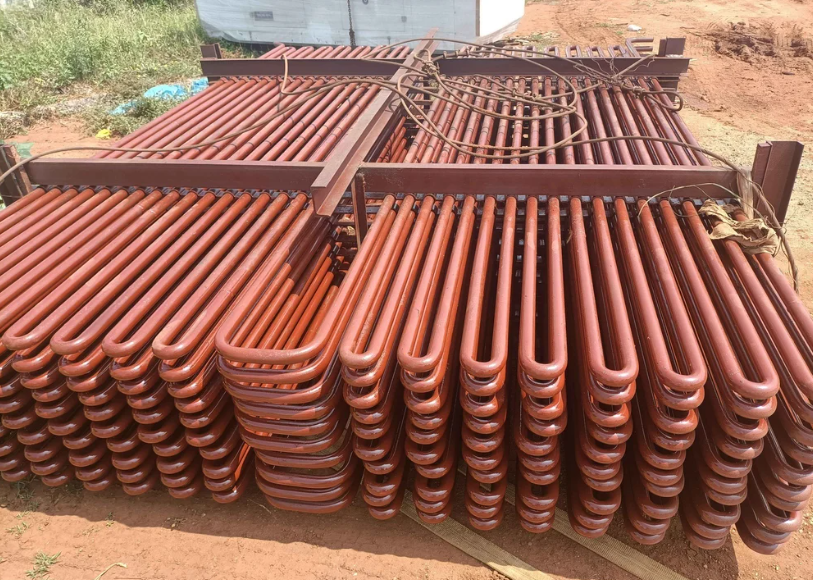When and Why to Replace Your Boiler Economiser Tubes: A Guide for Maintenance Teams
Boiler economiser tubes play a crucial role in improving the efficiency of steam boilers by recovering waste heat from exhaust gases and using it to preheat the feedwater. This process significantly reduces fuel consumption and operational costs, making economiser tubes a vital component of any industrial boiler system. However, like all mechanical parts, these tubes are subject to wear and tear over time, leading to potential efficiency losses, higher maintenance costs, and even system failures. In this blog, we’ll explore when and why you should consider replacing your boiler economiser tubes, providing essential insights for maintenance teams tasked with ensuring optimal boiler performance.
Understanding the Role of Economiser Tubes
Economiser tubes are designed to capture heat from the boiler's flue gases, which would otherwise be lost to the environment, and transfer it to the incoming feedwater. This process not only enhances the boiler's overall efficiency but also reduces the thermal stress on the boiler by gradually increasing the feedwater temperature before it enters the boiler drum.
Given their exposure to high temperatures, pressure fluctuations, and corrosive gases, economiser tubes are subject to various forms of degradation, including corrosion, erosion, and fatigue. Maintenance teams must regularly monitor the condition of these tubes to ensure they continue to function effectively.
When to Replace Boiler Economiser Tubes
Knowing when to replace boiler economiser tubes is crucial for avoiding unexpected downtime and costly repairs. Here are some key indicators that it may be time to consider replacement:
-
Significant Loss of Efficiency:
- One of the first signs that economiser tubes may need replacement is a noticeable drop in boiler efficiency. If the boiler requires more fuel to achieve the same steam output or if there’s a significant increase in flue gas temperatures, it could indicate that the economiser tubes are no longer effectively transferring heat.
-
Visible Corrosion or Erosion:
- Corrosion and erosion are common issues in economiser tubes, particularly in areas with high exposure to flue gases. Regular inspections should include checking for signs of pitting, scaling, or thinning of the tube walls. If corrosion or erosion is advanced, replacement is often the best course of action to prevent leaks or tube failures.
-
Frequent Tube Leaks:
- Leaks in economiser tubes are a clear sign of degradation. While minor leaks can sometimes be repaired, frequent or severe leaks indicate that the tubes have reached the end of their useful life. Repeated repairs can be costly and may not fully restore the tubes' integrity, making replacement a more cost-effective solution in the long run.
-
Excessive Fouling:
- Over time, economiser tubes can become fouled with soot, ash, or other deposits from the combustion process. While routine cleaning can mitigate this issue, excessive fouling that cannot be effectively removed may suggest that the tubes are nearing failure. In such cases, replacement may be necessary to restore the system's efficiency.
-
Material Fatigue:
- Repeated thermal cycling, where the tubes expand and contract due to temperature changes, can lead to material fatigue. This can manifest as cracking or other structural weaknesses in the tubes. Regular ultrasonic or radiographic testing can help identify early signs of fatigue. If these tests reveal significant material degradation, replacing the tubes is advisable to prevent catastrophic failures.
Why Replace Boiler Economiser Tubes?
Replacing boiler economiser tubes is a significant maintenance task, but it is often necessary to ensure the continued safe and efficient operation of the boiler. Here are some key reasons why replacement may be the best option:
-
Restoring Efficiency:
- As economiser tubes degrade, their ability to recover waste heat diminishes, leading to lower overall boiler efficiency. By replacing worn or damaged tubes, you can restore the system's performance, reduce fuel consumption, and lower operational costs.
-
Preventing Unplanned Downtime:
- A sudden failure of economiser tubes can lead to unplanned boiler shutdowns, causing costly production interruptions. Proactively replacing tubes that are nearing the end of their lifespan can help avoid these disruptions and ensure continuous operation.
-
Improving Safety:
- Boiler systems operate under high pressure and temperature, making safety a critical concern. Damaged or degraded economiser tubes pose a risk of leaks or ruptures, which can lead to dangerous situations. Replacing compromised tubes helps maintain the integrity of the boiler system and protects both equipment and personnel.
-
Compliance with Regulations:
- In the UK, boilers must comply with various health and safety regulations, including those related to emissions and energy efficiency. Replacing worn economiser tubes can help ensure that your boiler continues to meet regulatory standards, avoiding potential fines and legal issues.
-
Extending Boiler Lifespan:
- Regularly replacing economiser tubes as part of a proactive maintenance strategy can extend the overall lifespan of the boiler. By addressing wear and tear before it leads to more significant damage, you can maximise the return on investment in your boiler system.
Best Practices for Economiser Tube Replacement
When it comes to replacing economiser tubes, following best practices is essential to ensure a successful and efficient operation:
-
Schedule Replacement During Planned Maintenance:
- Whenever possible, schedule tube replacement during planned maintenance shutdowns to minimise the impact on production. This allows sufficient time for careful inspection, removal of old tubes, and installation of new ones.
-
Use High-Quality Replacement Tubes:
- Invest in high-quality replacement tubes that are designed to withstand the specific conditions of your boiler system. Consider factors such as material compatibility, corrosion resistance, and heat transfer efficiency when selecting new tubes.
-
Partner with Experienced Professionals:
- Replacing economiser tubes requires specialized skills and expertise. Work with experienced professionals who understand the complexities of boiler systems and can ensure the replacement is carried out safely and effectively.
-
Document and Monitor Performance:
- After replacement, carefully document the process and monitor the performance of the new tubes. This helps in identifying any issues early on and provides valuable data for future maintenance planning.
Conclusion
Boiler economiser tubes are critical to maintaining the efficiency and safety of industrial boiler systems. Understanding when and why to replace these tubes is essential for maintenance teams tasked with ensuring optimal boiler performance. By monitoring key indicators of tube degradation and following best practices for replacement, you can avoid costly downtime, improve safety, and extend the life of your boiler.
For maintenance teams in the UK, staying proactive in the care and replacement of economiser tubes is not just about maintaining operational efficiency—it’s about safeguarding the future of your business. For specialist advice and a no-obligation quotation, call IME on 02085996570 or email sales@imegroup.co.uk.

